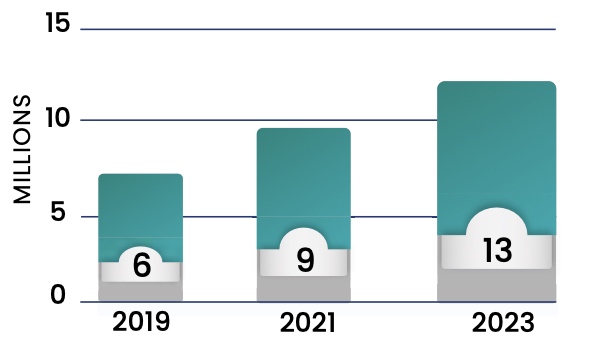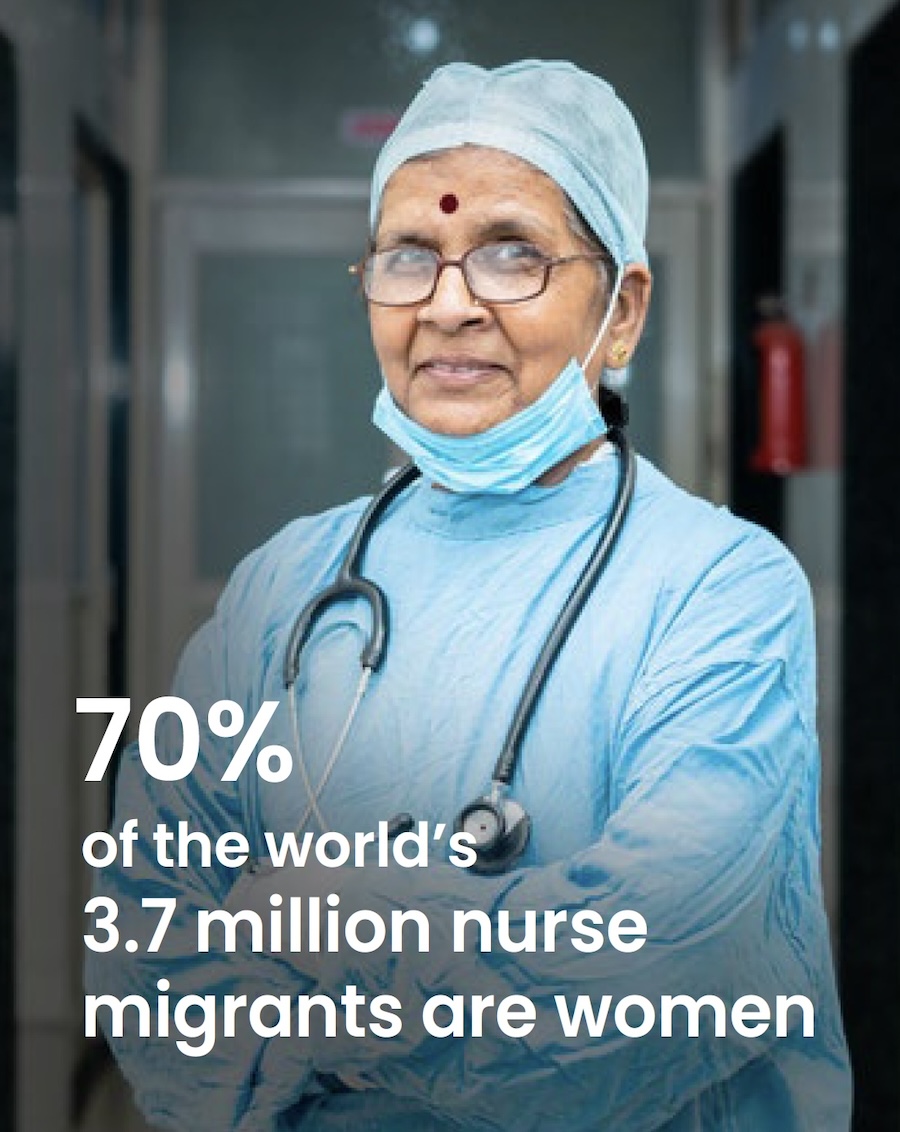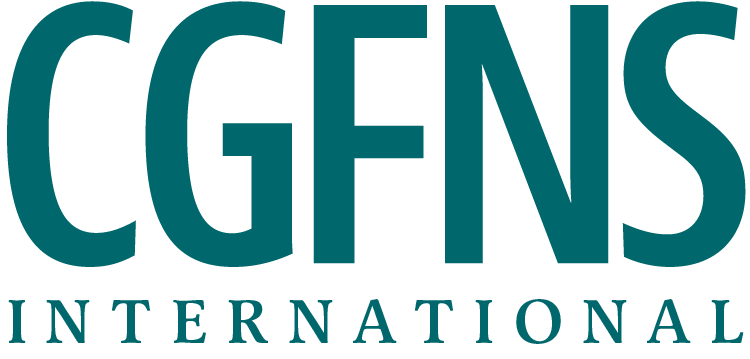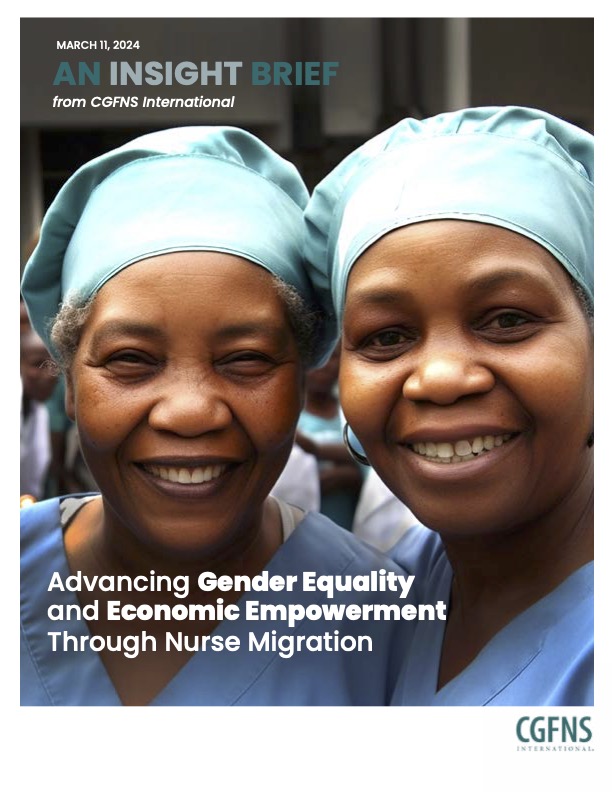Please select the appropriate button below to go the portal login based on your service need.
Gender Equality and Economic Empowerment through Nurse Migration
As the largest profession within healthcare, nursing is pivotal to a country’s ability to provide essential and comprehensive care. As a female-dominated profession, it offers unique economic opportunities to women, and nurses are often seen as beacons of female empowerment within their communities. Through global migration, nurses leverage their skills and competencies and gain significant opportunities for themselves and their families. This brief highlights the impacts of nursing and nurse migration in advancing gender equality and economic empowerment for women and girls.
27.9 million nurses globally,
90% of them, or
25.1 million, are women
The Role of Nursing
Nursing is a cornerstone in the global effort to foster gender equality and economic empowerment for women and girls. Beyond patient care and well-being, nursing successfully advances global social development efforts, notably the United Nations’ 2030 Agenda for Sustainable Development. Every day, nurses advance many of the Sustainable Development Goals through their work as clinicians, educators, and advocates, including poverty and hunger eradication (SDG 1 and SDG 2), universal health coverage (SDG 3), quality education (SDG 4), and gender equality (SDG 5). Beyond the bedside, the profession provides equitable employment opportunities that empower women economically (SDG 8) and addresses inequality and socio-economic disparities (SDG 10).
The predominance of women in nursing makes this profession pivotal in advancing gender equality worldwide. According to the World Health Organization (WHO), of the 27.9 million nurses globally, 90% of them, or 25.1 million, are women. By actively participating in this field, women advance their role in the workplace, foster empowerment, and inspire young girls to pursue diverse careers. Nurses serve as role models, showcasing the transformative impact of women in leadership positions within the healthcare sector. Still, limited healthcare leadership positions for women, evidence of a gender pay gap, and gender-based discrimination for nurses persist globally.
As the world grapples with severe health workforce shortages, exacerbated by factors such as demographic shifts and increased healthcare needs, millions of women around the world continue to provide critical and lifesaving care. As the demand for talent escalates, strategically addressing the shortage and role of health worker migration takes center stage.
Estimated Global Nursing Shortage by 2030

The Role of Global Nurse Migration
Most recent estimates by the International Centre on Nurse Migration (ICNM) predict a global nursing shortage of 13 million by 2030, more than double pre-COVID-19 estimates. This enormous shortfall poses a significant threat to public health systems and impedes the delivery of essential services, disproportionately affecting marginalized communities. The urgency to bridge this gap is intensified by the ongoing challenges posed by emerging health and demographic crises. The migration of nurses across borders has become a prevalent response to these workforce demands, highlighting the impor- tance of ethical international recruitment practices. Such practices are crucial to ensuring the equitable distribution of healthcare professionals while respecting their autonomy and the concerns of source countries.
The role of gender in nursing cannot be overlooked during the migration and integration processes. Today, the WHO estimates that 70% of the world’s 3.7 million nurse migrants are women. By addressing the gender dimensions of nurse migration, we can harness the potential of this profession to help lead the way toward global gender equality and the economic empowerment of women and girls.

The Role of Global Nurse Migration
Most recent estimates by the International Centre on Nurse Migration (ICNM) predict a global nursing shortage of 13 million by 2030, more than double pre-COVID-19 estimates. This enormous shortfall poses a significant threat to public health systems and impedes the delivery of essential services, disproportionately affecting marginalized communities. The urgency to bridge this gap is intensified by the ongoing challenges posed by emerging health and demographic crises. The migration of nurses across borders has become a prevalent response to these workforce demands, highlighting the impor- tance of ethical international recruitment practices. Such practices are crucial to ensuring the equitable distribution of healthcare professionals while respecting their autonomy and the concerns of source countries.
The role of gender in nursing cannot be overlooked during the migration and integration processes. Today, the WHO estimates that 70% of the world’s 3.7 million nurse migrants are women. By addressing the gender dimensions of nurse migration, we can harness the potential of this profession to help lead the way toward global gender equality and the economic empowerment of women and girls.
The Economic and Educational Profile of a Female Nurse Immigrant in the United States:
- Average salary: $72k, with 27% reporting an annual salary of +$90k
- 21% reported more than 20 years of experience in nursing
- 77% have a Baccalaureate degree or higher
- 50% used a recruiter to migrate
- 64% report sending remittances home monthly
Global Nurse Migration as a Driver of Gender Equality and Economic Empowerment
Across multiple surveys in recent years, CGFNS has seen a consistent gender breakdown hovering around 80% of respondents identifying as female, 20% identifying as male, and less than 1% preferring not to answer. By delving deeper into these survey responses, we have the opportunity to compare gender categories and project the economic impacts of nurse migration on these women and their families.
In the most recent survey conducted by CGFNS for its 2023 Economics of Nurse Migration report, by far the largest distinction between male and female respondent data was migration motivation. Twenty-four percent of women selected “economic” as their top migration driver versus 32% of men. For women, the top response was “familial” (34%) followed by “professional” (32%).
Despite fewer women citing economics as their primary reason for moving, our survey found no significant differences in annual salaries for men and women, but it did find that the number of years of experience was positively correlated to higher income. Given the often-drastic increase in annual salary for a migrating nurse—for example, a nurse in Philadelphia, Pennsylvania, makes on average 14 times more than a nurse in Manila, Philippines—the economic benefits of migrating for the individual are clear, even when increased costs of living are taken into consideration.
Sixty-four percent of female respondents reported sending money to their home countries monthly in a cycle known as remittances. This flow of money has a significant global impact, bringing some of the benefits of higher salaries back to sending countries. CGFNS estimates that female nurse migrants in the U.S. are earning and sending at least $1.2 billion annually to their home countries. This is particularly notable because remittances go directly to low- and middle-income recipients, directly improving their lives.
Half of female respondents reported using a recruiter during their migration to the U.S. This is a common pathway with many benefits that, by its nature, is a vulnerable process and can become an avenue for exploitation if not managed correctly. Survey data from the CGFNS Alliance for Ethical International Recruitment Practices, which certifies recruitment firms that demonstrate compliance with its ethical code, shows that 88% of migrating nurses who used an Alliance Certified Ethical Recruiter reported a positive or very positive experience. However, further attention and diligence are still required to ensure that all nurse migrants are treated fairly, especially considering the recurrence of reports of serious ethical violations like recruitment fees and visa documentation withholding.
Final Thoughts
As a female-dominated profession, the status of women and the status of nurses are closely intertwined. Nurse migration enables women to take their expertise across borders and brings economic benefits to individuals, families, and economies in both source and destination countries.
Although gender disparities, discrimination, and lack of leadership positions persist for women in the nursing profession, recognizing the pivotal role of nursing in advancing gender equality and economic empowerment for women and girls worldwide underscores the need for concerted efforts to support and empower this profession. As global nurse migration increases, CGFNS will continue to support women in nursing and recognize the important role that they play in providing lifesaving care while shifting gender dynamics for women and girls around the world.
Produced by CGFNS Global Affairs
Mukul Bakhshi, JD
Chief Global Affairs Officer
CGFNS International
Kaley Cook, MS
Program Manager
Alliance for Ethical International Recruitment Practices
Thomas Álvarez, MS
Global Affairs and Policy Specialist
CGFNS International






